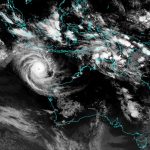 September 3, 2021 8:51 am
Published by Climate Extremes
September 3, 2021 8:51 am
Published by Climate Extremes
It has long been suggested in the literature, and discussed casually by meteorologists, that rainfall in Melbourne often occurs as lines of precipitation. However, this had yet to be quantified. CLEX researchers analysed 15 years of radar data from the Australian Radar Archive, using an objective method to identify and track these ‘linear systems’ based on radar reflectivity, size, and shape characteristics.
 April 13, 2021 2:05 pm
Published by Climate Extremes
April 13, 2021 2:05 pm
Published by Climate Extremes
Clemente Lopez-Bravo has created two datasets – L1 and L2 – of satellite observations of cloud properties across Australia and the Maritime Continent. The datasets, which have been released for the scientific community, are at a 2km spatial resolution at hourly intervals and cover five Austral summers in the period from November 2015 to March 2020.
 February 11, 2021 10:14 am
Published by Climate Extremes
February 11, 2021 10:14 am
Published by Climate Extremes
Storms cause ripples in the wind that travel upwards and away from the clouds, much like a stone causes ripples when it is thrown in a pond. These can then affect the temperature and winds around the storms and make them grow, last longer, or die earlier.
 October 20, 2020 9:43 am
Published by Climate Extremes
October 20, 2020 9:43 am
Published by Climate Extremes
CLEX researchers explore the challenges of identifying atmospheric rivers and find that detecting these events is highly variable according to resolution, and choice of the integrated water vapour transport thresholds. The uncertainties in a single detection method and data parameters may be as large as uncertainties across AR detection methodologies.
 June 22, 2020 3:47 pm
Published by Climate Extremes
June 22, 2020 3:47 pm
Published by Climate Extremes
This study investigates the influence of cold pools, which are evaporatively cooled regions of air near the surface, below thunderstorms, on the orientation of line‐organized thunderstorm clusters using computer model simulations.
 March 16, 2020 2:05 pm
Published by Climate Extremes
March 16, 2020 2:05 pm
Published by Climate Extremes
Observational studies over Darwin, Australia, show gravity waves provide a plausible explanation for the patterns of noteworthy variability in mesoscale motions. The findings suggest a two‐way coupling of clouds to their environment
 February 13, 2020 12:09 pm
Published by Climate Extremes
February 13, 2020 12:09 pm
Published by Climate Extremes
Using a novel methodology applied to CMIP5 projections CLEX researchers found that the local temperatures experienced by 90% of people would be substantially higher in a transient (still warming) climate than an equilibrium climate where the temperatures have plateaued, for the same global temperature.
 October 15, 2019 4:18 pm
Published by Climate Extremes
October 15, 2019 4:18 pm
Published by Climate Extremes
This research uses commercial aircraft data and high-resolution simulations to study a case in 2005 over the United States where severe turbulence was encountered about 50km away from a large mesoscale convective system. Of relevance, current aviation turbulence avoidance guidelines recommend avoiding storms by 32 km (20 miles).
 July 23, 2019 12:53 pm
Published by Jenny Rislund
July 23, 2019 12:53 pm
Published by Jenny Rislund
The CLEX node at University of Melbourne is offering several PhD scholarships on a competitive basis. Details of how to apply can be found on this page along with some example projects offered by our researchers.
 May 22, 2019 12:18 pm
Published by Climate Extremes
May 22, 2019 12:18 pm
Published by Climate Extremes
Thus study used satellite scatterometry to measure the horizontal component of winds over the sea surface in the Maritime Continent. It combined data with scatterometer to give additional insights into gravity wave structure in this region.










